Multi-Sensory Instruction: Moving Beyond the Sand Tray
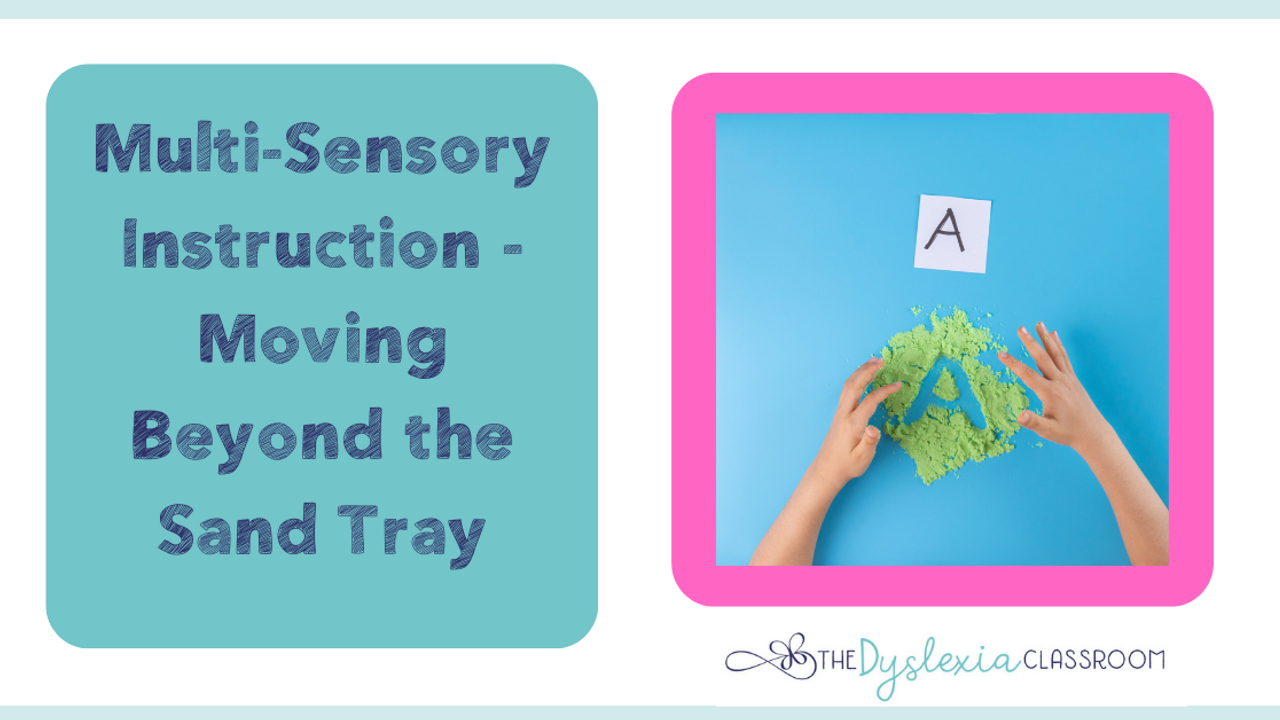
When you hear the word "multi-sensory," what comes to mind? For many who teach reading, especially to beginning readers, it may elicit images of hands-on activities, plastic letters, and sand trays. These are wonderful tools to incorporate into our structured literacy lessons (read more here), but there is so much more to multi-sensory instruction beyond the sand tray.
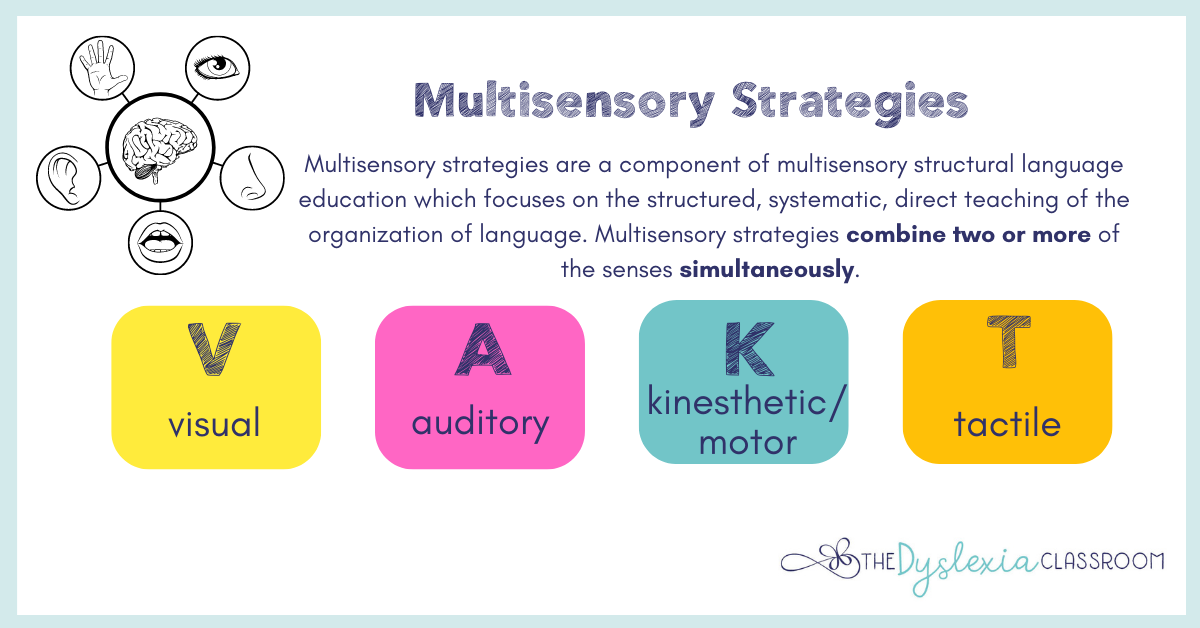
What Is Multi-Sensory Instruction?
Multi-sensory instruction means students simultaneously engage in two or more sensory modalities to take in and express information. These modalities are visual, auditory, kinesthetic/motor, and tactile. Multi-sensory teaching is often emphasized by those who work with dyslexic learners. Why? Most programs used with struggling or dyslexic learners are rooted in the Orton-Gillingham principles and include the direct, structured, systematic, and explicit teaching of the organization of language also referred to as Multisensory Structured Language Education (MSLE). These instructional practices embed multi-sensory strategies into lessons to engage the learner in techniques that connect visual-auditory-kinesthetic/motor-and tactile (VAKT) connections.
For those of us teaching structured literacy, we see the impact that multi-sensory strategies have on our learners. While it is difficult for researchers to tease out multi-sensory strategies from structured literacy instruction, it has been agreed upon that the positive impacts of multimodal methods in lessons are beneficial through the cognitive and neurological sciences.
Current research on working memory and cognition demonstrates the benefits of multimodal experiences with literacy elements. Incorporating multi-sensory strategies within a structured literacy approach to address phonemes, graphemes, letter knowledge, morphemes, etc., benefits students.
Simultaneous multisensory instruction purposefully integrates visual, auditory, and kinesthetic-motor (for speech and writing) pathways to support memory and learning of both oral and written language skills.
- Farrell, Mary L., White, Nancy Cushen; Multisensory Teaching of Basic Language Skills, Ch. 2, p.48
In addition, many students with learning differences, such as dyslexia, have coexisting deficits in working memory. One specific deficit for those with dyslexia is difficulties in phonological skills, and many students also struggle with rapid retrieval and short-term memory recall of verbal information. Using multi-sensory strategies supports connecting the oral language with visual language structures due to the activation of circuitry systems during language learning using a multimodal approach. When teaching reading and spelling, these multi-sensory experiences with linguistic units can activate more circuitry during language learning than if we only use one singular sensory experience. Read more about the reading brain here.
Multi-Sensory Instruction within a Structured Literacy Lesson
The science of reading is a collection of research about reading and the brain. This research is not new, but the term "science of reading" has become more mainstream as more people become aware of the decades of research and more in-depth reviews of curriculums. With this movement, we must be cautious that the science of reading doesn't become a buzzword. Structured literacy takes the science of research and puts it into action. The elements of Structured Literacy (phonology, sound-symbol associations, syllables, morphology, semantics, and syntax) set up ALL learners for success. Read more about Structured Literacy here.
When planning for our structured literacy lessons and embedding multi-sensory instruction, we must be mindful of why we use different components and how they aid learning and teaching.
Multi-sensory strategies planned ahead of time can ensure that the chosen strategy supports students and moves learning forward. In addition, multisensory strategies will shift as students gain automaticity in reading skills. Knowing how we use these different strategies and pieces is essential in focusing our instruction.
We can break down the common components of a structured lesson and see how intertwined multi-sensory strategies are with learning to read and write. These strategies connect and activate the regions of the brain and aid in creating a new neural circuitry system for reading to occur.
Examples of multi-sensory strategies within a structured literacy lesson
*These graphics are a partial list of multisensory strategies used within structured literacy lessons but designed to highlight those common teachings among those practitioners, teachers, and therapists who implement the science of reading.
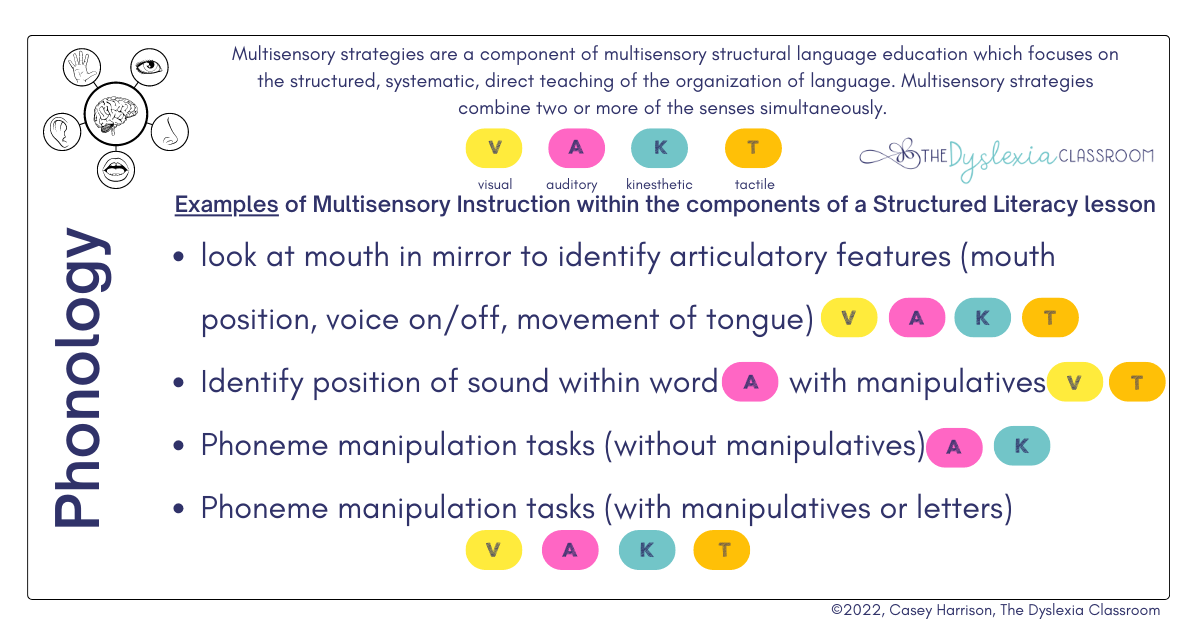
Phonology
Phonology is the science of speech sounds. This includes studying speech sounds development in a language and phonological awareness and phonemic awareness tasks. Phonological awareness and phonemic awareness are parts of the larger phonological processing umbrella, which "includes many aspects of speech and language perception and production" (Scarborough & Brady, 2002). Under this larger umbrella, phonological awareness provides the underpinnings for reading and writing.
Phonological awareness is the umbrella term that includes: phonemic awareness, rhyming, syllables, word awareness, onset-rime, and phoneme manipulation. Incorporating multisensory strategies within phonological and phonemic awareness tasks includes the simultaneous engagement of the auditory-visual-kinesthetic/motor-tactile modalities to solidify sound knowledge. Phonemic awareness teaches students to hear and manipulate the smallest units of sound and understand that spoken words are made up of sequences of speech sounds.
We can support phonemic awareness with students and engage the senses by bringing awareness to the articulatory features of individual phonemes or speech sounds as we link sounds to print, engaging the auditory-kinesthetic/motor modalities. Having students look in the mirror to identify their mouth position, tongue movement, and breath, when a sound is produced engages all the multisensory strategies (VAKT). Asking students to identify the position of a sound within a word engages the auditory memory, and when adding manipulatives or letters, adds in visual, kinesthetic/motor, and tactile senses.
The National Reading Panel showed that connecting letters to sounds (graphophonemic connections) during phonemic awareness tasks benefited students in reading and spelling. Children, especially those with a language-based learning difference like dyslexia, need direct, strongly auditory-based instruction in each of the 44 English language sounds to build sound-symbol correspondences. Read more about articulatory features here.
Teaching using as many learning pathways [multi-sensory strategies] in the brain simultaneously enhances memory and learning (IDA, 2008). See examples of multi-sensory strategies within the phonology component of a structured literacy lesson in the above image.
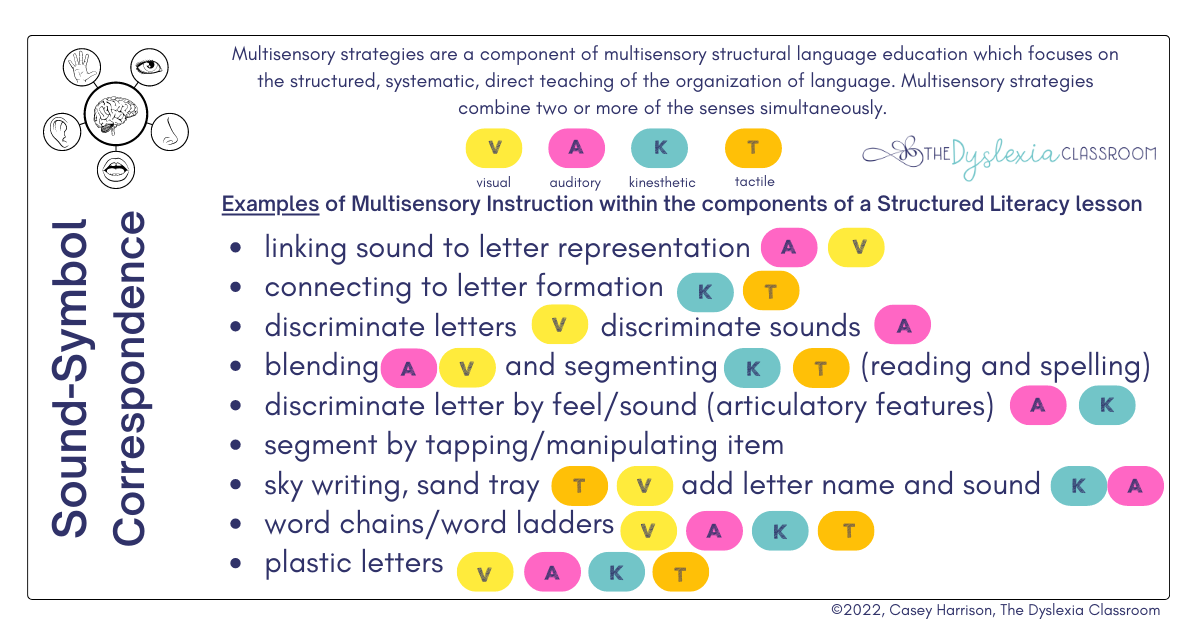
Sound-Symbol Correspondences
Sound-symbol correspondences encompass the alphabetic principle in connection to speech sounds. The connection of phonemes to graphemes is critical for learning to read and spell.
Linking sound to letter representation engages the auditory memory to the visual memory. Connecting to letter formations brings in a connection to the kinesthetic-tactile memory to help students remember the shape of a letter through muscle movement, feel of the letter, and sound. Tasks like segmenting, blending, manipulating sounds and letters are all examples of multisensory ways to connect sounds to letters. *See more on the image above.
Many educators use sand trays during this part of the structured literacy lesson. Sand trays provide a great VAKT connection to phoneme-grapheme correspondences; however, this is just one way to bring multi-sensory strategies to our lessons. The purpose of the sand for letter formation is to provide that kinesthetic/tactile connection to feel the letter formation. For this reason, we want to use the pad of our fingertips when writing on a textured surface. If we use something else, we are removing the multi-sensory piece. In addition, we want to use multi-sensory strategies to move students toward the application of skills in the general education classroom and expectations.
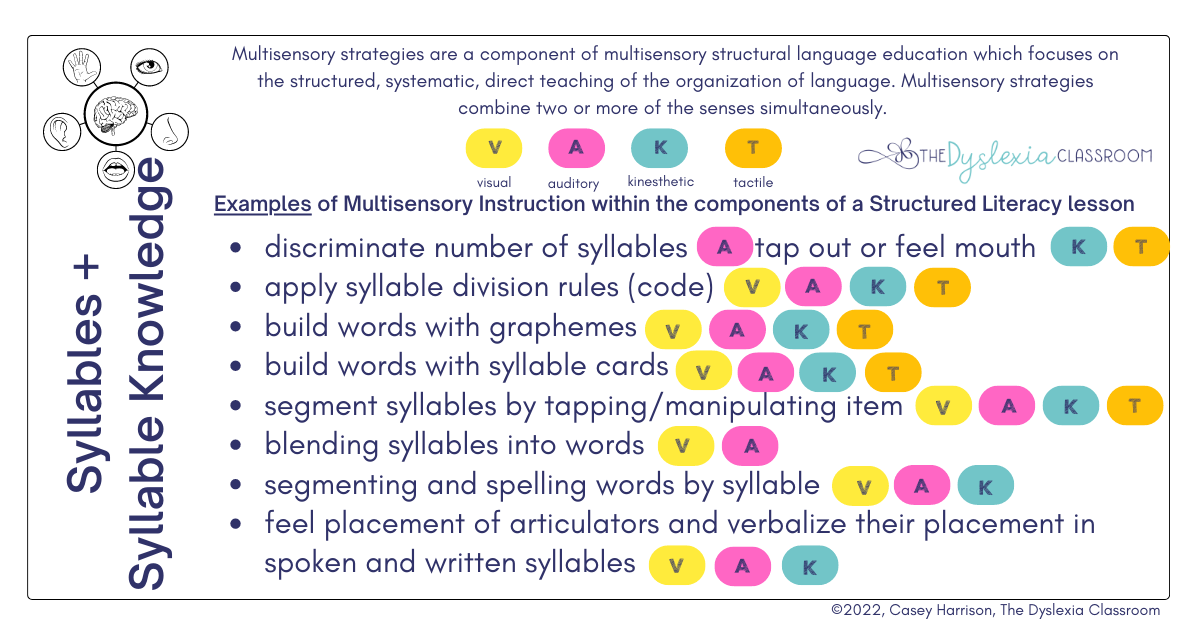
Syllables + Syllable Knowledge
Syllables + Syllable Knowledge includes patterns and the rules of our writing system. Most structured literacy lessons include explicit teaching of syllables, syllable division, and spelling conventions. Activities like segmenting syllables, tapping syllables, breaking them apart, and building words with graphemes and letter patterns engage multiple senses simultaneously. Activities like coding letters and syllables, mapping speech to print, and segmenting syllables provide hands-on multi-sensory engagement within lessons and empower students with strategies to read new unknown words.
See the image above for more strategies.
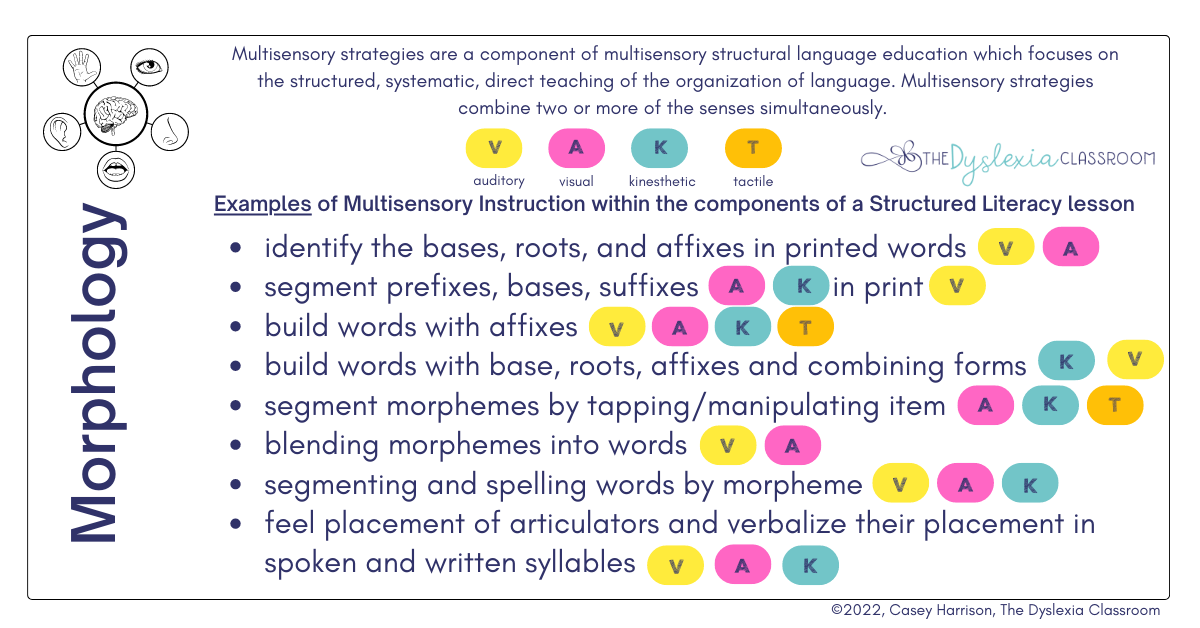
Morphology
Morphology addresses our understanding of the smallest units of meaning within our language. Students manipulate word parts (prefixes, suffixes, base words, and roots) to break down and build words. Hands-on activities like manipulating blocks with affixes and base words/roots/combining forms to create new words, building word matrices, and engaging in reading and spelling all encompass multimodal strategies. There are so many ways we can bring the senses into our learning! See the image for more examples.
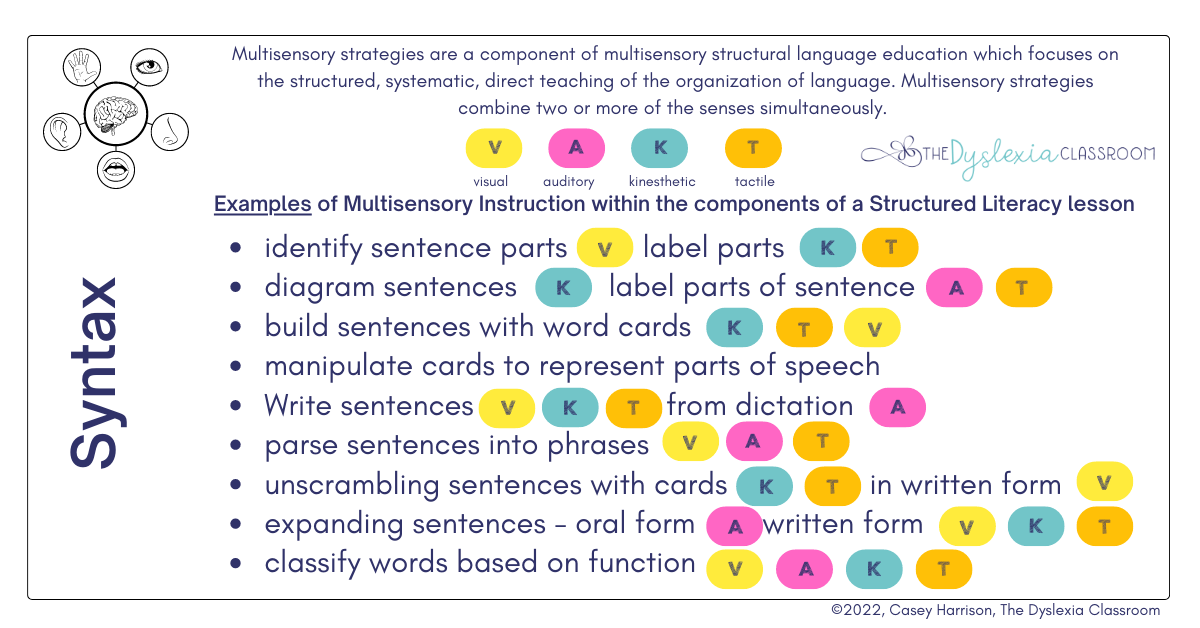
Syntax aids in our communication, including parts of speech and grammatical conventions, order of words, and word usage. We can have students diagram and label sentences, engaging in visual-auditory-kinesthetic-tactile senses. Activities like building sentences with word cards or unscrambling word cards with cards or in written form apply multi-sensory learning pathways. During our sessions, we may have students complete tasks like these in oral or written form, engaging in reading and writing tasks. See the image above for more examples of multi-sensory strategies within a structured literacy lesson.
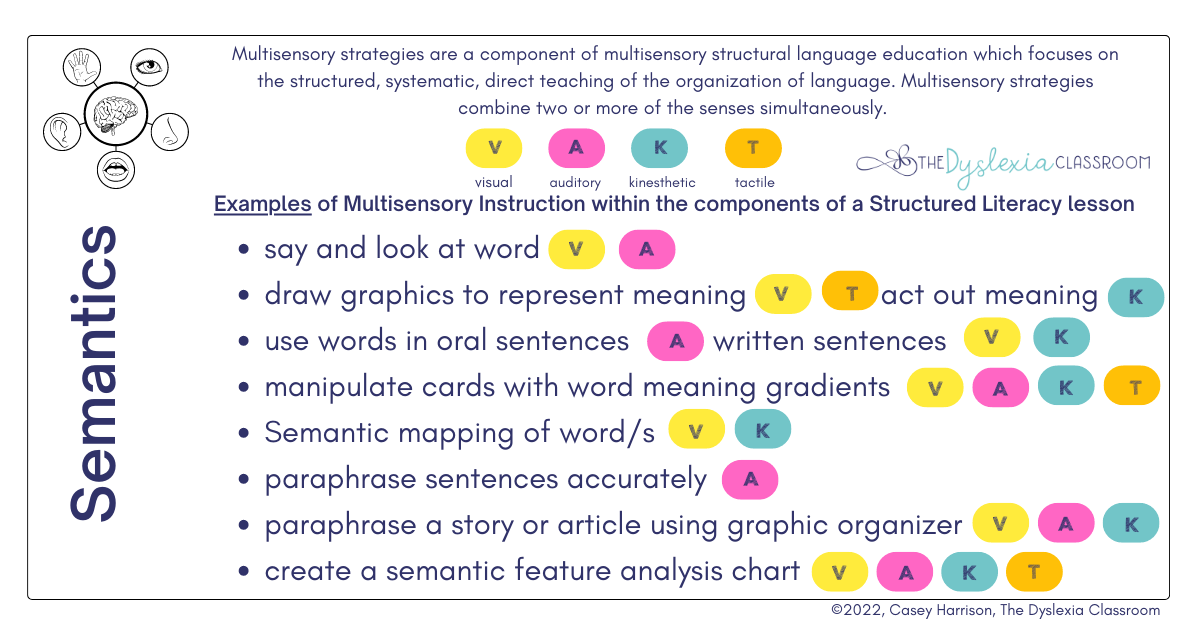
Semantics
Semantics refers to the layer of our language connected to meaning. Comprehension is the connection of oral and written language and encompasses vocabulary, word meaning, and word relations at the word, phrase, sentence, and text level. Reading comprehension is our goal, and activities like drawing semantic webs, paraphrasing text, and use of graphic organizers engage multiple learning pathways. See the image for more examples.
As you can see, structured literacy lessons weave in multi-sensory strategies throughout every component. While these are not comprehensive examples of the many ways multi-sensory strategies are included in lessons, the visual-auditory-kinesthetic-tactile connections are evident. Within a structured literacy lesson, all levels of language are addressed, including sounds (phonemes), symbols (graphemes), meaningful word parts (morphemes), word and phrase meaning (semantics), sentences (syntax), longer passages (discourse), and the social uses of language (pragmatics) (IDA, 2008).
When using a multi-sensory approach, we engage multiple areas of the brain, so we have these complex connections among the areas engaged, which are highly activated and widely distributed across the brain. What are some ways that you weave multi-sensory strategies into your lessons?

This information is the intellectual property of @2016 The Dyslexia Classroom. Do not use or repurpose without expressed permission from The Dyslexia Classroom. Please give The Dyslexia Classroom an attribution if you use, reference, or quote/paraphrase copyrighted materials. This includes but is not limited to blogs, social media, and resources.
References
Adams, M.J. (1990). Beginning to read: Thinking and learning about print. Cambridge: The MIT Press.
Farrell, M., Pickering, J., North, N., & Schavio, C., (2004, Fall). What is multisensory instruction? The IMSLEC Record, 8 (3).
Farrell, Mary L., White, Nancy Cushen; Multisensory Teaching of Basic Language Skills, Ch. 2, p.48.



